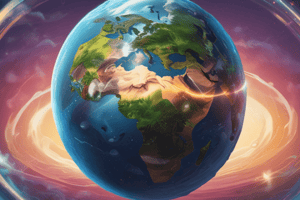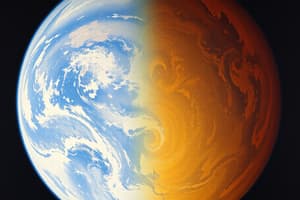Podcast
Questions and Answers
Which process involves the transportation of broken rock fragments from one place to another?
Which process involves the transportation of broken rock fragments from one place to another?
- Erosion (correct)
- Deposition
- Weathering
- Biogeography
What is the study of the distribution of plants, animals, bacteria, and fungi on Earth known as?
What is the study of the distribution of plants, animals, bacteria, and fungi on Earth known as?
- Deposition
- Phytogeography (correct)
- Human geography
- Geology
Which branch of geography examines how humans interact with each other and the planet?
Which branch of geography examines how humans interact with each other and the planet?
- Cultural geography
- Human geography (correct)
- Physical geography
- Geology
What did scientists analyze in the fossil record to understand the distribution of ancient species when the continents were one supercontinent known as Pangea?
What did scientists analyze in the fossil record to understand the distribution of ancient species when the continents were one supercontinent known as Pangea?
What is the main focus of cultural geography?
What is the main focus of cultural geography?
Which process involves changing larger rocks into smaller pieces due to wind, water, and glaciers?
Which process involves changing larger rocks into smaller pieces due to wind, water, and glaciers?
What do biogeographers study to understand more about the evolution of life?
What do biogeographers study to understand more about the evolution of life?
What is one key way scientists use the fossil record in biogeography?
What is one key way scientists use the fossil record in biogeography?
What causes the separation of Old World and New World monkeys, leading to differences in traits over time?
What causes the separation of Old World and New World monkeys, leading to differences in traits over time?
What plays a significant role in forming and modifying a landscape over a very long time?
What plays a significant role in forming and modifying a landscape over a very long time?
Which subcategory of biogeography studies the distribution of animals and bacteria?
Which subcategory of biogeography studies the distribution of animals and bacteria?
What are biogeographic regions often defined by within continents?
What are biogeographic regions often defined by within continents?
What is responsible for causing seasons on Earth?
What is responsible for causing seasons on Earth?
Which area experiences minimal temperature variations throughout the year?
Which area experiences minimal temperature variations throughout the year?
During which season in the Northern Hemisphere is the earth's axis tilted away from the sun?
During which season in the Northern Hemisphere is the earth's axis tilted away from the sun?
What occurs when the earth's axis is parallel to the sun in both the Northern and Southern Hemispheres?
What occurs when the earth's axis is parallel to the sun in both the Northern and Southern Hemispheres?
Which event marks the longest day of the year in the Northern Hemisphere?
Which event marks the longest day of the year in the Northern Hemisphere?
What happens during the winter solstice in the Southern Hemisphere?
What happens during the winter solstice in the Southern Hemisphere?
Which hemisphere experiences summer when the other experiences winter?
Which hemisphere experiences summer when the other experiences winter?
What does the term 'solstice' refer to in relation to seasons?
What does the term 'solstice' refer to in relation to seasons?
What development marked a significant transition in human history according to the text?
What development marked a significant transition in human history according to the text?
Which celestial body does not play a direct role in causing Earth's seasons?
Which celestial body does not play a direct role in causing Earth's seasons?
What type of line is drawn through the North and South Poles of Earth?
What type of line is drawn through the North and South Poles of Earth?
What landform type has a flat stretch of land with little elevational change?
What landform type has a flat stretch of land with little elevational change?
Which civilization is noted in the text for their reliance on iron as a natural resource?
Which civilization is noted in the text for their reliance on iron as a natural resource?
What landform is described as 'smaller than a mountain with a more gentle slope and rounded summit'?
What landform is described as 'smaller than a mountain with a more gentle slope and rounded summit'?
What theory explains the movement of Earth's tectonic plates caused by convection currents?
What theory explains the movement of Earth's tectonic plates caused by convection currents?
Which landform type juts away from the mainland and is surrounded by water on three sides?
Which landform type juts away from the mainland and is surrounded by water on three sides?
What do geomorphologists study to uncover clues about Earth's surface transformations?
What do geomorphologists study to uncover clues about Earth's surface transformations?
What type of landform is defined by an expansive, flat surface with at least one side rising steeply above the surrounding terrain?
What type of landform is defined by an expansive, flat surface with at least one side rising steeply above the surrounding terrain?
Which natural disaster involves rapidly moving tidal waves primarily caused by underwater earthquakes?
Which natural disaster involves rapidly moving tidal waves primarily caused by underwater earthquakes?
What region is referred to as the cradle of civilization due to early civilizations emerging there?
What region is referred to as the cradle of civilization due to early civilizations emerging there?
What do scientists measure in centimeters per year to support the plate tectonics theory?
What do scientists measure in centimeters per year to support the plate tectonics theory?
What feature of the Earth's terrain do geomorphologists study to understand changes over time?
What feature of the Earth's terrain do geomorphologists study to understand changes over time?
What type of landform has a gradual incline extending inland from the ocean's floor?
What type of landform has a gradual incline extending inland from the ocean's floor?
What is the primary reason the region of Mesopotamia is often called the cradle of civilization?
What is the primary reason the region of Mesopotamia is often called the cradle of civilization?
How did the Incas overcome challenging geography and climate conditions to build Machu Picchu?
How did the Incas overcome challenging geography and climate conditions to build Machu Picchu?
What landform type is characterized by at least one side rising steeply above the terrain and having a flat surface?
What landform type is characterized by at least one side rising steeply above the terrain and having a flat surface?
Plate tectonics theory suggests that the movement of Earth's plates is primarily driven by:
Plate tectonics theory suggests that the movement of Earth's plates is primarily driven by:
What gives scientists insights into the Earth's interior and helps them understand earthquake causes?
What gives scientists insights into the Earth's interior and helps them understand earthquake causes?
Which natural event can cause massive destruction due to rapidly moving tidal waves?
Which natural event can cause massive destruction due to rapidly moving tidal waves?
What does the theory of plate tectonics provide an explanation for?
What does the theory of plate tectonics provide an explanation for?
What landform type is a semi-circular pool of seawater wedged between two peninsulas or two headlands?
What landform type is a semi-circular pool of seawater wedged between two peninsulas or two headlands?
What do geomorphologists study to uncover clues about Earth's surface changes over time?
What do geomorphologists study to uncover clues about Earth's surface changes over time?
How do scientists measure the movement of Earth's tectonic plates to support the plate tectonics theory?
How do scientists measure the movement of Earth's tectonic plates to support the plate tectonics theory?
What type of landform has a gradual incline extending inland from the ocean's floor?
What type of landform has a gradual incline extending inland from the ocean's floor?
How do geomorphologists uncover clues about changes in Earth's surface due to weathering events?
How do geomorphologists uncover clues about changes in Earth's surface due to weathering events?
What is the primary difference between weathering and erosion?
What is the primary difference between weathering and erosion?
How do human geographers differ from cultural geographers?
How do human geographers differ from cultural geographers?
Why is water erosion typically faster than wind and glacial erosion?
Why is water erosion typically faster than wind and glacial erosion?
How do scientists use biogeography to understand Earth's past climate?
How do scientists use biogeography to understand Earth's past climate?
Which subcategory of biogeography focuses specifically on the distribution of animals and bacteria?
Which subcategory of biogeography focuses specifically on the distribution of animals and bacteria?
In biogeography, how do scientists analyze the fossil record to understand the distribution of ancient species?
In biogeography, how do scientists analyze the fossil record to understand the distribution of ancient species?
What does cultural geography primarily focus on?
What does cultural geography primarily focus on?
What plays a significant role in shaping the configuration of a landscape over time?
What plays a significant role in shaping the configuration of a landscape over time?
How do scientists use biogeography to study the evolution of life?
How do scientists use biogeography to study the evolution of life?
What defines phytogeography in biogeography?
What defines phytogeography in biogeography?
What factor primarily influences biogeographic regions within continents?
What factor primarily influences biogeographic regions within continents?
Which branch of geography explores how humans interact with each other and their environment?
Which branch of geography explores how humans interact with each other and their environment?
What causes seasons on Earth?
What causes seasons on Earth?
What is the significance of the summer solstice?
What is the significance of the summer solstice?
Which hemisphere experiences summer when the other experiences winter?
Which hemisphere experiences summer when the other experiences winter?
What term is used to describe the day when the Earth's axis is either closest or farthest from the sun?
What term is used to describe the day when the Earth's axis is either closest or farthest from the sun?
What key development marked a significant transition in human history according to the text?
What key development marked a significant transition in human history according to the text?
During which season do spring and fall occur in both Hemispheres?
During which season do spring and fall occur in both Hemispheres?
In which region of the globe do temperatures experience very little variation throughout the year?
In which region of the globe do temperatures experience very little variation throughout the year?
What term refers to an imaginary line drawn through the North and South Poles around which Earth rotates?
What term refers to an imaginary line drawn through the North and South Poles around which Earth rotates?
What type of landform has a flat surface with at least one side rising steeply above surrounding terrain?
What type of landform has a flat surface with at least one side rising steeply above surrounding terrain?
What occurs when the Northern Hemisphere is tilted away from the sun?
What occurs when the Northern Hemisphere is tilted away from the sun?
Flashcards are hidden until you start studying
Study Notes
Geographical Processes
- The transportation of broken rock fragments from one place to another is known as erosion.
- Weathering is the process of changing larger rocks into smaller pieces due to wind, water, and glaciers.
Branches of Geography
- Biogeography is the study of the distribution of plants, animals, bacteria, and fungi on Earth.
- Human geography examines how humans interact with each other and the planet.
- Cultural geography focuses on the main aspects of human culture and their impact on the environment.
Biogeography
- Biogeographers study the fossil record to understand more about the evolution of life.
- One key way scientists use the fossil record in biogeography is to analyze the distribution of ancient species.
- Zoogeography is a subcategory of biogeography that studies the distribution of animals and bacteria.
- Phytogeography is a subcategory of biogeography that studies the distribution of plants.
- Biogeographic regions are often defined by climate, vegetation, and species within continents.
Earth's Seasons
- The Earth's axis tilt causes seasons on Earth.
- The equator experiences minimal temperature variations throughout the year.
- When the Northern Hemisphere is tilted away from the sun, it is winter, and when it is tilted towards the sun, it is summer.
- The summer solstice marks the longest day of the year in the Northern Hemisphere.
- The opposite hemisphere experiences summer when the other experiences winter.
- The term 'solstice' refers to the longest or shortest day of the year.
Earth's Surface
- Geomorphologists study the Earth's surface transformations by examining landforms, such as mountains, hills, and plateaus.
- A plateau is a flat stretch of land with little elevational change.
- A hill is a landform that is smaller than a mountain with a more gentle slope and rounded summit.
- A peninsula is a landform that juts away from the mainland and is surrounded by water on three sides.
- A continental shelf is a gradual incline extending inland from the ocean's floor.
- A bay is a semi-circular pool of seawater wedged between two peninsulas or two headlands.
Plate Tectonics
- The theory of plate tectonics explains the movement of Earth's tectonic plates caused by convection currents.
- Scientists measure the movement of Earth's tectonic plates in centimeters per year to support the plate tectonics theory.
- Plate tectonics theory provides an explanation for the formation of mountains, volcanoes, and earthquakes.
Natural Events
- Tsunamis are natural disasters that involve rapidly moving tidal waves primarily caused by underwater earthquakes.
- Seismic activity gives scientists insights into the Earth's interior and helps them understand earthquake causes.
Studying That Suits You
Use AI to generate personalized quizzes and flashcards to suit your learning preferences.




